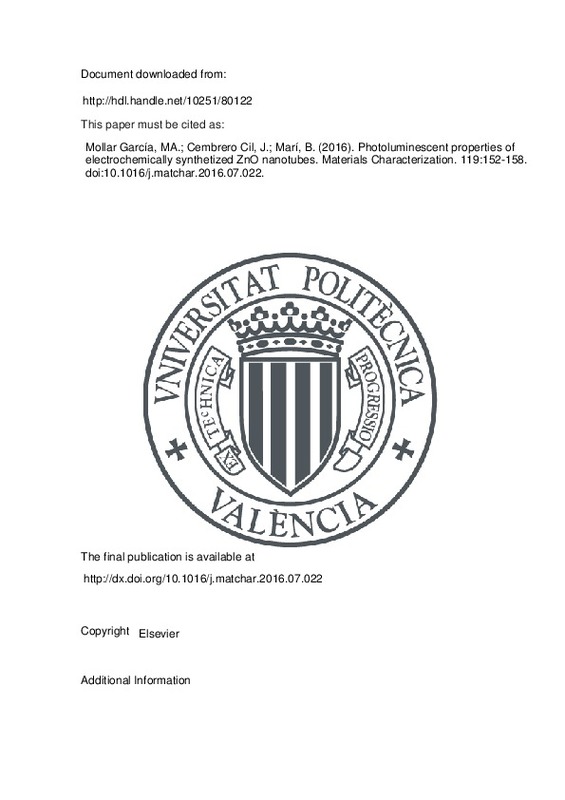JavaScript is disabled for your browser. Some features of this site may not work without it.
Buscar en RiuNet
Listar
Mi cuenta
Estadísticas
Ayuda RiuNet
Admin. UPV
Photoluminescent properties of electrochemically synthetized ZnO nanotubes
Mostrar el registro sencillo del ítem
Ficheros en el ítem
| dc.contributor.author | Gracia Jimenez, J. M.
|
es_ES |
| dc.contributor.author | Cembrero Cil, Jesús
|
es_ES |
| dc.contributor.author | Mollar García, Miguel Alfonso
|
es_ES |
| dc.contributor.author | Marí Soucase, Bernabé
|
|
| dc.date.accessioned | 2017-04-27T11:23:17Z | |
| dc.date.available | 2017-04-27T11:23:17Z | |
| dc.date.issued | 2016-09 | |
| dc.identifier.issn | 1044-5803 | |
| dc.identifier.uri | http://hdl.handle.net/10251/80122 | |
| dc.description.abstract | ZnO nanotubes were prepared by a sequential combination of electrochemical deposition, chemical attack and regeneration. ZnO nanocolumns were initially electrodeposited on conductive substrates and then converted into nanotubes by a process involving chemical etching and subsequent regrowth. The morphology of these ZnO nanocolumns and derived nanotubes was monitored by Scanning Electron Microscopy and their optical properties was studied by photoluminescence spectroscopy. Photoluminescence were measured as a function of temperature, from 6 to 300 K, for both nanocolumns and nanotubes. In order to study the behaviour of induced intrinsic defect all ZnO films were annealed in air at 400 °C and their photoluminescent properties were also registered before and after annealing. The behaviour of photoluminescence is explained taking into account the contribution of different point defects. A band energy diagram related to intrinsic defects was proposed to describe the behaviour of photoluminescence spectra | es_ES |
| dc.description.sponsorship | This work was supported by Ministerio de Economia y Competitividad (ENE2013-46624-C4-4-R) and Generalitat Valenciana (Prometeus 2014/044). | en_EN |
| dc.language | Inglés | es_ES |
| dc.publisher | Elsevier | es_ES |
| dc.relation.ispartof | Materials Characterization | es_ES |
| dc.rights | Reserva de todos los derechos | es_ES |
| dc.subject | Defects | es_ES |
| dc.subject | Growth from solution | es_ES |
| dc.subject | Nanocolumns | es_ES |
| dc.subject | Nanotubes | es_ES |
| dc.subject | Photoluminescence | es_ES |
| dc.subject | Zinc oxide | es_ES |
| dc.subject.classification | FISICA APLICADA | es_ES |
| dc.subject.classification | CIENCIA DE LOS MATERIALES E INGENIERIA METALURGICA | es_ES |
| dc.title | Photoluminescent properties of electrochemically synthetized ZnO nanotubes | es_ES |
| dc.type | Artículo | es_ES |
| dc.identifier.doi | 10.1016/j.matchar.2016.07.022 | |
| dc.relation.projectID | info:eu-repo/grantAgreement/GVA//PROMETEO%2F2014%2F044/ | es_ES |
| dc.relation.projectID | info:eu-repo/grantAgreement/MINECO//ENE2013-46624-C4-4-R/ES/MEJORA DE LA CONVERSION DE ENERGIA SOLAR MEDIANTE PROCESOS DE EXCITACION ELECTRONICA EN DOS ETAPAS. APROXIMACION ELECTROQUIMICA./ | es_ES |
| dc.rights.accessRights | Abierto | es_ES |
| dc.contributor.affiliation | Universitat Politècnica de València. Escuela Técnica Superior de Ingenieros Industriales - Escola Tècnica Superior d'Enginyers Industrials | es_ES |
| dc.contributor.affiliation | Universitat Politècnica de València. Escuela Técnica Superior de Ingeniería del Diseño - Escola Tècnica Superior d'Enginyeria del Disseny | es_ES |
| dc.description.bibliographicCitation | Gracia Jimenez, JM.; Cembrero Cil, J.; Mollar García, MA.; Marí Soucase, B. (2016). Photoluminescent properties of electrochemically synthetized ZnO nanotubes. Materials Characterization. 119:152-158. https://doi.org/10.1016/j.matchar.2016.07.022 | es_ES |
| dc.description.accrualMethod | S | es_ES |
| dc.relation.publisherversion | http://dx.doi.org/10.1016/j.matchar.2016.07.022 | es_ES |
| dc.description.upvformatpinicio | 152 | es_ES |
| dc.description.upvformatpfin | 158 | es_ES |
| dc.type.version | info:eu-repo/semantics/publishedVersion | es_ES |
| dc.description.volume | 119 | es_ES |
| dc.relation.senia | 322697 | es_ES |
| dc.contributor.funder | Ministerio de Economía y Competitividad | es_ES |
| dc.contributor.funder | Generalitat Valenciana | es_ES |







![[Cerrado]](/themes/UPV/images/candado.png)

